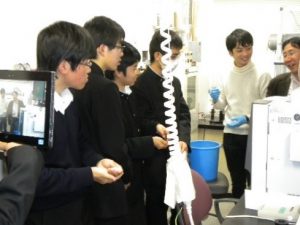Date: March 18th 2016
Time: 2pm to 4:40pm
Participants: Group C2 (six people)
- Introduction to the mineral processing laboratory
- The present conditions of methane hydrate development in Japan
- Gas hydrate related study introduction
- Visit to the laboratory
- Questions and answers
 Summary
Summary
We wish to do research on methane hydrate as a source of energy via mining it for methane gas. We will also look at extraction methods such as methane fermentation (heat-treatment and alkali processing) and other sources for extracting methane (e.g. garbage).
For excavating the methane hydrate our SGH group will focus on the “Substitution Method”, which was suggested to us, over the “Decompression Method”. The Substitution Method uses a modified Carbon dioxide Captured and Storage method (CCS), which is the process of sending waste CO2 to the bottom of the sea instead of into the atmosphere, in order to release methane from the methane hydrate while also keeping the hydrate structure intact. This method reduces the amount of CO2 released into the atmosphere while also preventing the hydrate structure from being compromised. According to computer simulations however, it is difficult to use the Substitution Method and extract ideal product from the methane hydrate.
Furthermore, when extracting methane from the methane hydrate impurities, such as hydrogen sulfide, may be extracted with the methane as mentioned by the methods of the Kyoto University researchers report. Another issue is transportation. Two methods used are “Ion Liquid” (using various liquids that have been carefully studied) which promotes hydrate growth and rapid hardening, and “Gas Separation Film” in order to prevent the methane from mixing with impurities. Research on finding the most efficient transportation method is becoming more commom
According to research, using the Substitution Method on a ship combined with using a gas exchange membrane to purify the extracted methane could lower the cost of excavating the methane hydrate. This is outlined in the research done by The Kusada Laboratory.
Visit to Laboratory
At the Kusada Laboratory at Kyoto University we were able to look at hydrates first hand as well as the device that produces it. The device (which was designed by the Kusada Lab, but made by a gas company) was not able to produce a pure sample of methane hydrate, however it was able to make a pure sample of carbon dioxide hydrate. Due to this we were not able to look at a good sample of methane hydrate, but were still able to look at an example of a hydrate with the pure carbon dioxide hydrate sample.

